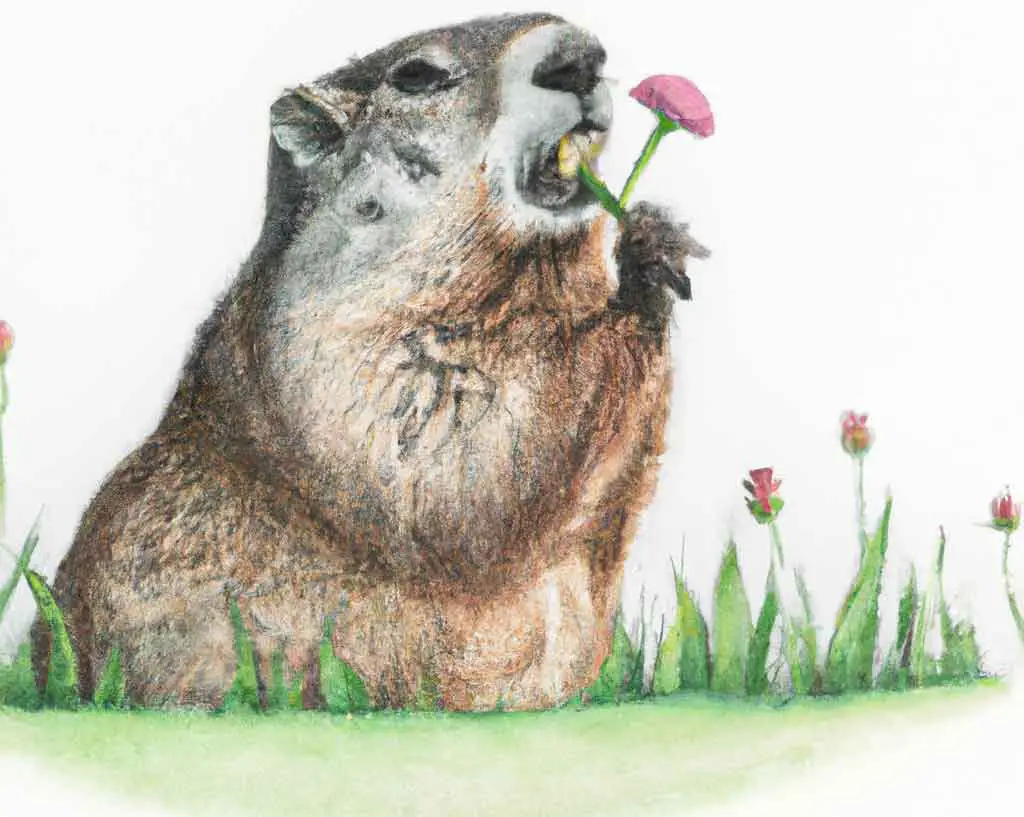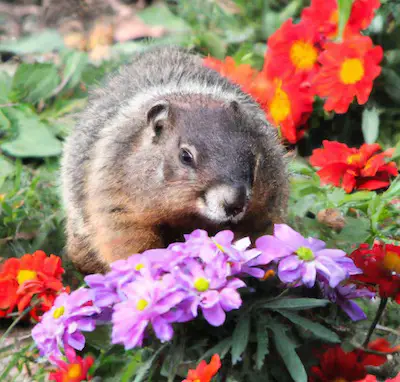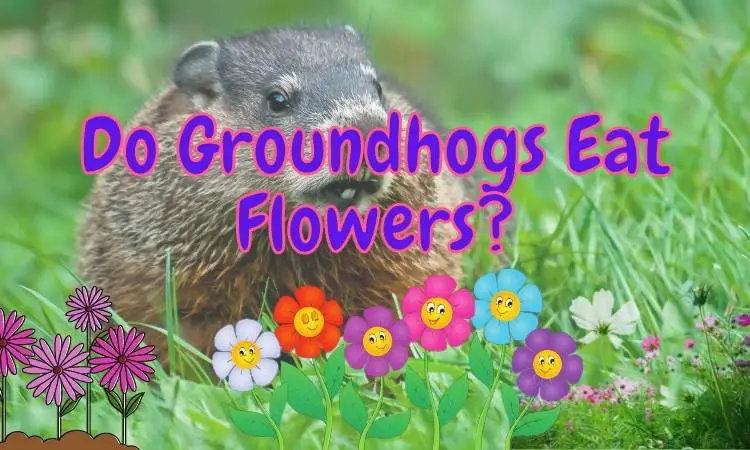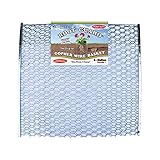Groundhogs, also known as woodchucks, are a type of rodent that eats primarily plants. They will eat almost anything from your backyard – some of their favorites are tomatoes, zucchini, and even onions!
Groundhogs love flowers and they will eat many of the most popular flowers grown in backyards as well as wildflowers in meadows and lawns. Here we will take a look at the flowers groundhogs love (and hate!) the most and give you some tips and tricks on how to prevent them from eating your precious flowers and plants.
Included in their vegetarian diet are many types of flowers that they eat predominantly in the summer, but also throughout the rest of the year – depending on the flowering season of the specific flower!
What Types of Flowers Do Groundhogs Eat?
Groundhogs eat many types of flowers. They eat some common backyard flowers such as marigolds, daylilies, roses, and zinnias. They also eat less common flowers like impatiens and petunias.

Do Groundhogs Eat Sunflowers?
Yes! Groundhogs love sunflower plants, but they mostly eat the seedlings (when small). They have a hard time reaching the flowers of the fully grown adult plant.
But they may occasionally bite over the stem so the sunflower plant falls down and the flower head becomes accessible to them,
They also love munching on sunflower seeds in the fall!
Do Groundhogs Eat Mums?
Yes, groundhogs will eat mums (Chrysanthemum flowers) and parts of the plant including the roots, but they are not their favorite flowers in most backyards!

Mums contain a toxin that is only really toxic to insects but also tastes bitter for most animals. However, they are not toxic to groundhogs and other larger animals.
Groundhogs will usually not bother with eating your mums, unless nothing else of interest is present in your yard!
Do Groundhogs Eat Petunias?
Yes, groundhogs do eat petunias. Especially the younger plants!
They are in the same family as tomatoes and potatoes which are sometimes also eaten by groundhogs.
Although they belong to the nightshade family, toxic to most animals, groundhogs can eat the flower parts without intoxication.

They prefer the stems of the younger flowers but also eat the flowers and have even been seen sucking out the liquid from the inside of the flower buds.
Sometimes they also nibble the leaves or eat the roots of the plants from below!
Do Groundhogs Eat Impatiens?
Yes, groundhogs do eat impatiens. In contrast to Petunias, Impatiens can be eaten in large amounts by most animals, but are slightly toxic to humans. Groundhogs eat the flowers and leaves of impatiens during certain times of flowering in spring.

Do Groundhogs Eat Marigolds?
Yes, groundhogs do eat marigolds, but they are not their favorite flowers. They suck out the liquid inside the flower buds and also feed on flowers and sometimes also the leaves, stems, and seeds throughout the summer and fall months.

They will continue to feed on them throughout the winter months. They are safe to eat for most animals and humans until they begin to wilt.
Do Groundhogs Eat Daylilies?
Yes, groundhogs do eat daylilies, although slightly poisonous to them. They don’t taste as good as other garden flowers, but if a groundhog is really hungry it will eat almost anything!
Lilies can be quite toxic to many animals, including cats, and also to groundhogs as well in large amounts.

Daylilies are a type of flowering plant that belongs to the genus Hemerocallis.
They are native to Asia and have been introduced to many other parts of the world. Daylilies are popular garden plants because they are easy to grow and care for.
They are rarely eaten by animals as the toxin contained in daylilies affects the kidneys of most animals and can be fatal if eaten in large amounts – even for groundhogs! Although the petals of the flowers are less toxic than the stems, seeds, and roots.
Do Groundhogs Eat Roses?
Yes, groundhogs do eat roses. They feed on them in the spring and summer months when they are flowering. They do not eat the stems and leaves.
Some roses are toxic, but most are edible to animals like groundhogs and other rodents.
Groundhogs will eat petals of roses but not the entire flower head. If there are many groundhogs in an area, they can completely strip the flowers off of the bush.
Do Groundhogs Eat Zinnias?
Yes, groundhogs do eat zinnias. They will suck out the nectar from the flower buds and also eat the seeds throughout the summer and fall. They will continue to eat them, except into the winter months when they are not flowering.

Zinnias are flowering plants in the genus Zinnia. They are native to Mexico and Central America, and they are widely cultivated in North America. All parts of the plant are edible for most animals, but not all animals like the taste!
What flowers will groundhogs not eat?
Apart from some of the flowers mentioned above, there are many flowers that yard owners may care about.
And whereas groundhogs will eat many types of flowers to a lesser degree than their favorites, there are definitely flowers that are more groundhog safe than others!
There are some types of flowers that groundhogs will perhaps smell and taste, but they will not eat them as their main source of food if other food items are available.
These flowers that are fairly groundhogs safe are:
- Bleeding Heart
- Pulmonaria
- Coleus
- Lavender
- Thyme
- Blue Salvia
- Sedum
- Russian Sage
- Phlox
- Lamium
- Lambs Ears
- Nicotiana
- Euphorbia
- Astilbe
- Ageratum
- Coralbells
- Catmint
- Mums
- Yarrow
- Hardy Geraniums
- Plumbago
- Agastache
- Wax Begonias
- Goldenrod
- Ferns
- Gaillardia
- Salvia
- Hosta
- Threadleaf Coreopsis
- Angelonia
- Foamflowers
- Amsonia
- Iris
- Daylilies
- Helleborus
- Beebalm
- Alyssum
- Geraniums
- Perilla And Vinca
- Barrenwort
- Monkshood
- Cleome
It depends slightly on the time of year and the age of the groundhog, but these should include most flowers that yard owners are concerned with!
How Do I Prevent Groundhogs From Eating My Flowers?
There are several things that can be done to prevent groundhogs from eating flowers in your backyard. Also, see my recent post if you want a full list of my favorite methods to keep groudnhogs and gophers away!
1. Using ultrasonic sound
Gophers, like other pest mammals that may invade your garden, tend to have very good hearing. This means that loud or consistent noises will scare them away or at least shorten their visits.
Check out my full buying guide for these ingenious ultrasonic repeller devices here!
One of my favorite technologies to keep pests away from my backyard is these cool solar-powered ultrasonic sound emitters that you can buy right from Amazon! In my experience, they really work, and the solar panels on top save you the time and money of changing batteries all the time.
They will also work against rodents like gophers, mice, and rats!
2. Sprinkling natural repellents
Gophers may be scared off by using natural scents such as coyote urine or predator scents.
They may also cause them to leave if there is a combination of sounds being played from a radio. The sounds include the sound of barking dogs and coyotes.
You can sprinkle dog hair, cayenne pepper or strong enteric oils and other natural repellents around the garden to keep the groundhogs away.
See my complete list of humane ways to keep groundhogs away from your yard for more tips and tricks!
3. Fencing around the garden
You can also fence around your garden to keep gophers from entering the garden. It should be at least 3 feet deep and have a double row of fencing.
Groundhogs are good diggers so it has to go underground or they may find a way into the garden even with the fences in place!
4. Using live traps
You can use a live trap to capture gophers and move them to another area. Live trapping is currently the most humane way of groundhog control. Once you have removed all groundhogs from an area, it is important to ensure that they do not come back by using fencing or other barriers to block access.
You can also just buy a live trap, as the sturdy metal ones shown here:
To lure the groundhogs in, you can use one of the numerous favorite foods of groundhogs or an optimized extra attractive formula like this one to make the catch even quicker!
5. Using natural pesticides
There are pesticides or rodent toxins that can be used to kill groundhogs on your property. These may also affect other animals in the area so it is important to ensure that they are only sprayed on the targeted plants.
I do not recommend these, as I prefer more humane ways as described here. Also, anything that kills an animal will also harm humans to some degree, so go for a repellant rather than a toxin if you go the chemical route!
6. Using Scarecrows
You can use a scarecrow in your garden to keep groundhogs away. Groundhogs are afraid of novelty so time-sensitive or motion-activated scarecrows may also be effective in keeping them out of the garden.
7. Using Lights
Groundhogs are not strictly nocturnal animals but they are most active at low light so they do avoid areas with bright lights.
Motion-activated lights, sounds, and sprinklers may help prevent groundhogs from entering your yard.
Any blinking light will confuse and scare away groundhogs from your yard, especially if they are motion activated and sudden!
8. Motion-activated sprinklers
Like most animals, groundhogs hate surprises, and they will run away if suddenly sprayed with water. I like this solution because it is humane, simple, effective, and does not require much time to set up.
The Havahart 5277 is a motion-activated sprinkler that is activated by the movement of animals up to 25 feet away and sprays them with a harmless water jet, frightening them off and keeping them at bay.
The included metal stake makes it easy to install in your garden, and the sprinkler can be rotated 180 degrees for maximum coverage.
What Other Animals Would Eat Flowers in My Backyard?
There are quite a few animals that will eat flowers in your yard. Rabbits, deer, squirrels, raccoons, mice, and skunks are all common animals that can cause damage to your flowers.
The methods mentioned in the list above will keep all these pests away!
Groundhogs are omnivores so they will eat flowers as well as some beneficial insects in your garden.
You can prevent them from eating your flowers by fencing your garden, sprinkling repellents around the area, placing solar powered ultrasonic repellents or using live traps to remove groundhogs.















